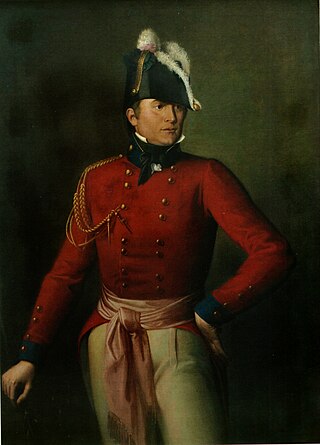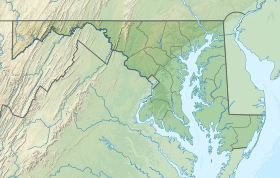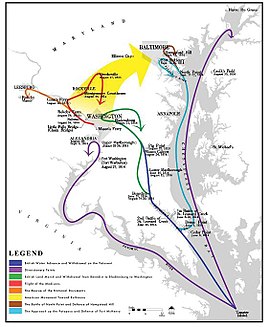
Havre de Grace, abbreviated HdG, is a city in Harford County, Maryland, United States. It is situated at the mouth of the Susquehanna River and the head of Chesapeake Bay. It is named after the port city of Le Havre, France, which in full was once Le Havre de Grâce.
The Battle of York was a War of 1812 battle fought in York, Upper Canada on April 27, 1813. An American force, supported by a naval flotilla, landed on the western lakeshore and captured the provincial capital after defeating an outnumbered force of regulars, militia and Ojibwe natives under the command of Major General Roger Hale Sheaffe, the Lieutenant Governor of Upper Canada.

Major-General Robert Ross was an Irish officer in the British Army who served in the Napoleonic Wars and its theatre in North America in the War of 1812.

John Rodgers was a senior naval officer in the United States Navy during its formative years in the 1790s through the late 1830s. He served under six presidents for nearly four decades. His service took him through many military operations in the Quasi-War with France, both Barbary Wars in North Africa, and the War of 1812 with Britain.

The Battle of Baltimore took place between British and American forces in the War of 1812. American forces repulsed sea and land invasions off the busy port city of Baltimore, Maryland, and killed the commander of the invading British forces.

The Battle of Bladensburg, also known as the Bladensburg Races, took place during the Chesapeake Campaign, part of the War of 1812, on 24 August 1814, at Bladensburg, Maryland, 8.6 miles (13.8 km) northeast of Washington, D.C.

The Burning of Washington, also known as the Capture of Washington, was a successful British amphibious attack conducted by Rear-Admiral George Cockburn during Admiral Sir John Warren's Chesapeake campaign. It was the only time since the American Revolutionary War that a foreign power had captured and occupied a United States capital. Following the defeat of American forces at the Battle of Bladensburg on August 24, 1814, a British army led by Major-General Robert Ross marched on Washington, D.C. That evening, British soldiers and sailors set fire to multiple public buildings; including the Presidential Mansion, United States Capitol, and Washington Navy Yard.

The Battle of North Point was fought on September 12, 1814, between General John Stricker's Maryland Militia and a British force led by Major General Robert Ross. Although the Americans retreated, they were able to do so in good order having inflicted significant casualties on the British, killing one of the commanders of the invading force, significantly demoralizing the troops under his command and leaving some of his units lost among woods and swampy creeks, with others in confusion.

The Battle of Craney Island was a victory for the United States during the War of 1812. The battle saved the city of Norfolk, and the adjacent city of Portsmouth, from British invasion. Especially important to Virginia and northeastern North Carolina, the region was a major hub for American commerce.

The Battle of St. Michaels was an engagement contested on August 10, 1813, during the War of 1812. British soldiers attacked the American militia at St. Michaels, Maryland, which is located on Maryland's Eastern Shore with access to Chesapeake Bay. At the time, this small town was on the main shipping route to important cities such as Baltimore and Washington, D.C.
The Raid on Gananoque was an action conducted by the United States Army on 21 September 1812 against Gananoque, Upper Canada during the War of 1812. The Americans sought to plunder ammunition and stores to resupply their own forces. Gananoque was a key point in the supply chain between Montreal and Kingston, the main base of the Provincial Marine on the Great Lakes. Under the command of Captain Benjamin Forsyth, the Americans departed Ogdensburg, New York and sailed to Gananoque, where they encountered resistance from the 2nd Regiment of Leeds Militia. The British militia was forced to retreat and the Americans successfully destroyed the storehouse and returned to the United States with captured supplies. As a result of the raid, the British strengthened their defences along the St. Lawrence River.
The Battle of Caulk's Field was fought during the War of 1812 in Kent County, Maryland between a small British Army force commanded by Captain Sir Peter Parker and American militia forces commanded by Lieutenant Colonel Philip Reed. Parker, who was operating in the Chesapeake Bay region as part of the British campaign against Baltimore, Maryland, landed on the eastern shore of the Chesapeake Bay to move against Reed's militia encampment. The British attacking force encountered American skirmishers, who conducting a fighting retreat, drawing the British towards the main American line. Parker was mortally wounded during the fight, and the British force withdrew after Parker fell. Later British setbacks at the Battle of North Point and the Battle of Fort McHenry led the British to abandon their campaign against Baltimore. In 2012, the battlefield was the site of an archaeological survey.

The Chesapeake campaign, also known as the Chesapeake Bay campaign, of the War of 1812 was a British naval campaign that took place from 23 April 1813 to 14 September 1814 on and around the Delaware and Chesapeake bays of the United States.

The Raid on Alexandria was a British victory during the War of 1812, which gained much plunder at little cost but may have contributed to the later British repulse at Baltimore by delaying their main forces.

Concord Point Light is a 36-foot (11 m) lighthouse in Havre de Grace, Maryland. It overlooks the point where Susquehanna River flows into the Chesapeake Bay, an area of increasing navigational traffic when it was constructed in 1827. It is the northernmost lighthouse and the second-oldest tower lighthouse still standing on the bay.
HMS Highflyer was originally an American privateer schooner built in 1811. As a privateer she took several British vessels as prizes. The Royal Navy captured her in 1813. She then participated in several raids on the Chesapeake and coastal Virginia before the Americans recaptured her later in 1813.
The Raid on Port Dover was an episode during the War of 1812. American troops crossed Lake Erie to capture or destroy stocks of grain and destroy mills at Port Dover, Ontario, which were used to provide flour for British troops stationed on the Niagara Peninsula. At the instigation of Lieutenant Colonel John B. Campbell and without sanction from his superiors or the government of the United States, the Americans also destroyed private houses and other property, prompting British commanders to demand reprisals in other theatres of the war. To some degree, the burning of Washington by the British later in the year was influenced by the American actions at Port Dover.

The Second Battle of St. Michaels was a raid conducted on Maryland's Eastern Shore by British soldiers during the War of 1812. The raid occurred on August 26, 1813, at points between Tilghman Island and the town of St. Michaels, Maryland. Local militia defended against the raiders.
John O'Neill was an American military officer, manufacturer and lighthouse keeper. He defended Havre de Grace, Maryland, during the Raid on Havre de Grace on May 3, 1813, during the War of 1812. He then served as lighthouse keeper at Concord Point Light from 1827 to his death.















